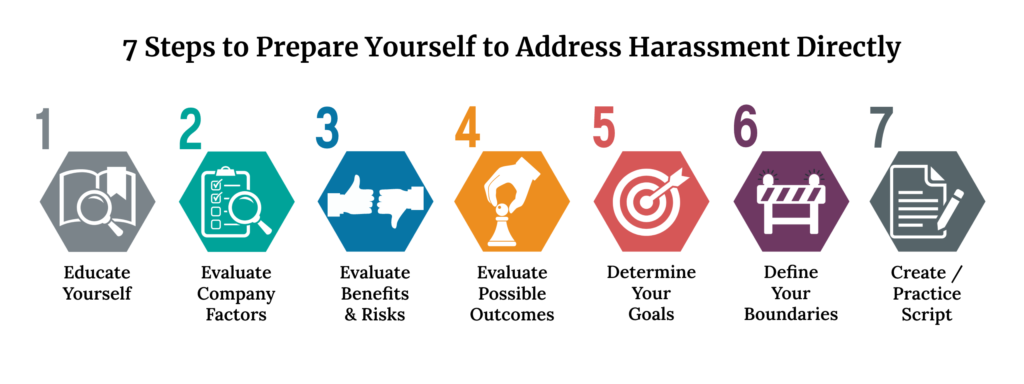Should You Address Harassment Directly?

When someone says or does something inappropriate, our first reaction is usually shock, often followed by stunned silence. Embarrassed and humiliated, we wonder how we should respond.
If someone else is present, it may even appear that we have no reaction, and therefore no issue.
The truth is, our reaction is often internal. We go through disbelief and denial, hoping what just happened didn’t actually happen.
Sometimes we address the behavior when it occurs . But there are good reasons we may stay silent. Addressing harassment directly, by talking one-on-one after the incident, can often resolve the behavior quickly and efficiently.
When we haven’t responded in the moment, we may begin a process of self doubt and second guessing. “That can’t be right.” or “I’m being too sensitive.” or “I must have misunderstood.” Once reality sets, we get upset with how we handled it in the moment. “I should have said something.” or “It’s too late to do anything about it now.” Lastly we wonder what we should do next – wait and see? hope it doesn’t happen again? let it slide?
And the kicker is, the time it takes to fully understand what happened, how you feel about it, and the full impact of harassing behavior, can take weeks and sometimes months.
“The single most critical activity for effective conflict management is deemed by respondents to be conversation. “
The Goal of Addressing Harassment Directly
When you’re ready, ask yourself what you want the outcome to be. Does communicating directly accomplish this? If so, continue reading. If not, consider sending The BeeMail, telling an ally or your boss or taking a complaint to HR.
Some outcomes are:
- Make the problem go away as quickly as possible, with as few ripples as possible
- Call attention to and stop the behavior
- Put it on the record so if the behavior continues, it is documented
- Keep your complaint “unofficial,” avoid the risk of going to HR, and maintain that option if harassment continues
The BeeMail Option
Not everyone feels comfortable speaking to the person harassing them directly. Confronting a bully or harasser directly is a daunting prospect. And you may not have the skills to manage this effectively, without assistance.
We recognized this gap in the available solutions for addressing workplace harassment quickly and effectively. To close this gap, The Wolf and The Bee have created a new option: The BeeMail.
The BeeMail is designed to provide individuals with a less risky means of addressing harassment directly with their colleague, early on, while the problem remains manageable.
Address Harassment Directly
Confronting the person directly is often the quickest and least risky way to address harassment. Prepare for a more effective conversation with these seven steps.

1. Educate Yourself
Regardless of what you decide to do, it is important to document the incident. (Download Documentation Templates)
- Check your employee manual on the policy and process for reporting harassment.
- Make notes about pertinent parts of the policy or process.
- Determine the type of harassment and discrimination you are experiencing or witnessing HERE.
- Determine the level of harassment you are experiencing by checking the Harassment Meter.
2. Evaluate Company Factors
Only you understand the dynamics at work and in your personal life. It is important to evaluate all the information and put it into context with your life.
- Who are your allies? This can be a witness, your boss, a co-worker
- What type of relationship do you have with the person who harassed you? Is it purely professional, friendly, contentious, third party, etc.?
- What is their standing and status at the company?
- What is your company culture regarding harassment?
- What is the likelihood the problem will be resolved without escalation?
- How comfortable are you with initiating difficult conversations or conflict resolution?
3. Evaluate Benefits and Risks
Create an outline of all the potential benefits and risks of addressing harassment directly:
- What are the risks and benefits of inaction? Of communicating directly? Of escalating the issue to your boss or HR?
- Here are some potential benefits and risks to consider:
Benefits of Addressing Harassment Directly
- Potential to resolve a problem before it escalates
- Empowers you to speak your boundaries and hold that person accountable to those boundaries
- Gets the complaint on the record, so if the behavior continues you have a positive track record for trying to resolve the problem directly
- Keeps your complaint “unofficial” without going through a formal company process
RISKS of Addressing Harassment Directly
- The conversation is awkward, and uncomfortable
- Your complaint is dismissed, belittled
- Retaliation for “complaining”
- Labeled difficult, disloyal, not a team player
- Continued or escalating harassment
RISKS IF YOU DON’T Address Harassment Directly
- Awkwardness, discomfort at work continues
- Harassment continues or escalates
- Your silence is interpreted as you are OK with the behavior, or worse, that you are complicit with the behavior
- Your silence could be used against you if you must escalate
4. Evaluate Possible Outcomes
Envision the outcome you desire. This will help you define your goals. Look at all possible outcomes to give you clues as to whether communicating directly is something you are comfortable doing. Think about all possible outcomes including positive, negative, and worst case scenario. Do a gut check as you write these possible outcomes down. Here are some possible outcomes:
- The problem is resolved (YAY!)
- Harassment continues
- Harassment gets worse
- Retaliation
5. Determine Your Goals
Have a goal in mind to keep you on track before, during and after your meeting.
- What is your goal for addressing harassment directly?
- What type of acknowledgement do you need to hear for your complaint to be resolved?
- What type of commitment do you want in order for this problem to be resolved?
6. Write Down Your Boundaries
Evaluate your boundaries. Be specific about the boundaries that were crossed. Be clear and specific about your boundaries moving forward. This will be key information to communicate during your meeting.
- What boundaries were crossed?
- What boundaries need to be respected going forward?
7. Create and Practice a Script
Part of feeling confident in a meeting like this, is leaving as little to chance as possible. Unfortunately you can only control what you say and how you say it. Write down a script and practice what you want to say out loud. Practice in the mirror. Practice with a friend. You can script out what you will say if your complaint is dismissed or minimized as well.
Here is a script outline you can use:
- I wanted to talk with you about what happened [at location or date].
- Briefly summarize behavior.
- Summarize how their behavior impacted you. Use “I” statements where possible: “I feel that type of joke is inappropriate for work. I felt uncomfortable when…”
- Provide the resolution you need to see: “I would like an apology.” “I think an apology to the team is in order.” “This behavior needs to stop immediately.”
- Take a moment to listen to their response.
- Once a resolution has been committed to, provide an incentive for moving on: “Thank you for your commitment to [resolution]. I look forward to putting this incident behind us.”
Get more ideas here: Scripts to Address Harassment Directly
The Meeting
Request a One-On-One Meeting
- Request a meeting to ensure you have privacy to talk without interruption.
- If you have a witness with you, this may make the other person defensive, and inhibit your goal of reaching a resolution. It can also give you a witness to your meeting. Before your meeting, coordinate with your witness about what their role in the meeting will be. During your meeting, explain the purpose of their attendance.
- Sending a meeting request. This creates a record of the meeting.
Get Straight to the Point
- Once you are in the meeting, there is no need to engage in small talk. Dive right in, so you are not sidetracked by work business or other issues.
- Use your script. If you practiced, this should act as a security blanket, and reduce some of your anxiety.
- Be clear with your proposed resolution.
- Be clear regarding your willingness to move on.
Listen
- Listen to objections, explanations or excuses that are used to dismiss or minimize your complaint.
- Listen to how your complaint is received and addressed.
- Listen for a commitment to your proposed resolution.
- Listen to questions asked or alternative proposed resolutions.
- Listen for a clear agreement and resolution.
Wrap-Up
- Confirm the meeting resolution.
- If there is no resolution, tell them you will need some time to digest what was said in the meeting and leave. Do not threaten further action.
Post Meeting Action
- Send an email with meeting summary.
- Document the meeting (see template HERE)
- Confirm they follow through on the their agreed to actions.
- Wait and see – watch for continued behavior, retaliation or positive resolution.
If the Problem is Not Resolved
If addressing harassment directly is not an option at this time, or if harassment continues, escalates, or you experience retaliation, you have additional options to consider:
- Report the issue/s to your boss or supervisor
- Make a complaint with your HR department
- File a complaint with the EEOC
- If you are considering leaving your job due to ongoing harassment, consult with an attorney
- Remember to document everything
Share your experience and recommendations in our Facebook group HERE.
Get the Latest Buzz
Subscribe to our regular newsletter for the latest news and actions. Your info and time is safe with us!
The Latest News
- May 2025 – NewsletterReading Time: 2 minutesThe latest news includes a NEW audio feature, a big impact milestone, and a new section of the Navigating Workplace Harassment User Guide.
The Latest Blog
- 5 Workplace Red Flags You Shouldn’t IgnoreReading Time: 4 minutesWorkplace harassment assumes many guises, Identifying when your workplace is unsafe and unhealthy is essential. Here are five workplace red flags you should never overlook.



